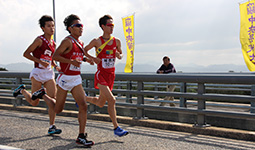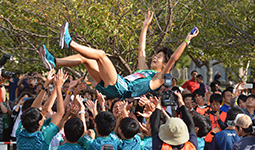Home > Highlighting JAPAN > Highlighting Japan October 2019 > THE SPORTING LIFE
Highlighting JAPAN


Ekiden, Connecting People
Ekiden is a long-distance relay road race in which runners pass a cloth sash, or tasuki, to the next runner on their team having completed their leg. Ekiden competitions are held throughout Japan, with many people gathering along the route to cheer the runners on.
Originating in Japan, ekiden is a long-distance relay road race and one of the nation’s most popular athletics events. Japan holds inter-prefectural team races, corporate team races, school- and university-based team races, as well as wheelchair races. The total distance, number of runners, and distance run by each participant varies depending on the event, but typically involves teams of 5 to 8 runners covering a distance of between 42.195 kilometers—the length of a marathon—and around 100 kilometers.
“A team with a single fast runner cannot win an ekiden. Equally, if one runner is off form and loses time, other team members can make it up. Also, since the ekiden is a long-distance event, the position of the teams may change along the way so the winning team is not known until the end. It’s a race that offers plenty of drama,” says Yukio Seki of the Japan Association of Athletics Federation.
By far the most popular ekiden competition of any in Japan is the Tokyo-Hakone Round-Trip College Ekiden Race, commonly known as the Hakone Ekiden, which is held annually on January 2 and 3. This is a 217.1 kilometer race over ten stages, starting from Otemachi in central Tokyo, climbing uphill to Mt. Hakone, and ending at Ashinoko Lake. The Hakone Ekiden is an annual New Year’s event in Japan, with more than one million supporters lining the route.
The first ekiden ever held in Japan was the Tokaido Ekiden Toho Kyoso in 1917, with two teams of twenty-three runners each running around 500 km between Kyoto and Tokyo over three days. The race followed the historical Tokaido road that was built in the Edo period. Since ancient times, people ran or rode on horseback between each station along the highway, “transmitting” goods and information. This race is said to have been the first time that the term “ekiden,” a combination of the words “eki” meaning “station” and “den” meaning “transmit,” was used.
Later, the first Japanese Olympian, Shiso Kanakuri (1891–1983), helped to popularize ekiden as a sporting event in Japan. Kanakuri participated in the 1911 Stockholm Olympic marathon but could not finish. On returning to Japan, the disappointed Kanakuri worked hard to improve the skills of Japanese long-distance runners. In 1920, a relay race was held by students from the Kanto region. This was the first Hakone Ekiden event, which has continued to this day. The style of running that requires participants to pass on a sash called a “tasuki” that hangs from the shoulder instead of a baton has not changed to this day. The tasuki are in team colors and show the name of the team, enhancing the sense of unity between its members.
“Receiving the tasuki worn by the previous runner and passing it on to the next runner enhances the sense of group camaraderie. I think the tradition of ekiden in Japan is the reason why Japanese athletes are so good at long distance competitions that require solitude and endurance,” says Seki.
Recent ekiden competitions have seen the participation of international athletes. Kenyan athletes in particular actively participate. Douglas Wakiihuri, for example, who won the silver medal in the marathon at the 1988 Seoul Olympics, trained in Japan’s jitsugyodan corporate team system as an ekiden runner.
“There was a time when International ekiden competitions were held in Japan, and some countries, such as France, continue to hold ekiden races,” says Seki.
Ekiden do not have to be large-scale events, but can also be enjoyed by smaller groups such as families, schools and communities.
“People seem to enjoy small-scale events too, such as family competitions between mixed teams of adults and children running in their neighborhood. I would urge you to experience ekiden for yourself once and see just how much fun it is,” says Seki.
Ekiden is not only about the result of the race. The true joy is to be found in the deepened bonds that are formed between teammates, family and fellow residents by passing on the tasuki.
© 2009 Cabinet Office, Government of Japan









